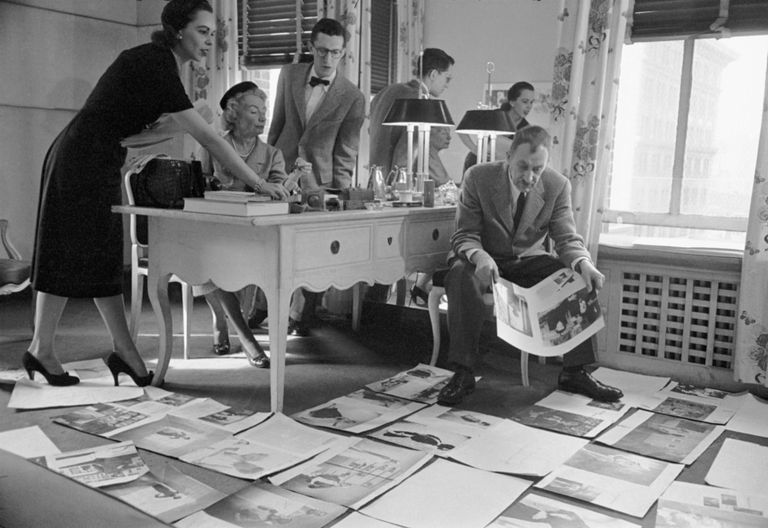Part 2: Creating the Right Connections
If you missed Part 1 of ‘Carmel Snow: The Art of Having a Fulfilling Career’, you can catch up here: Carmel’s 6 Life Lessons.
* I can earn a small commission as an Amazon Associate for qualifying purchases through the affiliate links on this page.
Carmel Snow is famous for having a flair for finding the greatest talents of her time and this contributed to her fulfilling career. Snow was devoted to her work and creating the right connections was a crucial part of her career.
As she had set out to create the publication “for the well-dressed woman with the well-dressed mind”, Snow needed the right people. In order to get them, she was the generous one upfront. This is a shortlist of Carmel’s acquaintances that she helped leap to stardom.
Martin Munkacsi
Carmel Snow saw some of Munkacsi’s news photographs and “craving to get some fresh air” into her magazine, Snow booked Munkacsi for a beachwear photoshoot. That resulted in Harper’s Bazaar 1933 December edition, the ‘Palm Beach’ bathing suit editorial.
This editorial made history even though it set off to a rather difficult start as Munkacsi didn’t know much English. After a while, realizing their language barrier, Martin was gesturing at Snow and Brokaw. Lucille Brokaw, the model, interpreted his signs and ran. The shutter closed, Munkacsi has taken the iconic shot, which became the first instance of a fashion model being photographed in motion.

This collaboration between Snow and Munkacsi gave the fashion industry a push for change in scenery and technique. Martin, as a photojournalist, was doing something intuitive to him ─ capturing the moment.





Nonetheless, what was natural to him brought a completely new perspective to the fashion editorial. As Richard Avedon, in a tribute to Munkacsi, described his contribution to fashion photography:
“He brought a taste for happiness and honesty and a love of women to what was, before him, a joyless, lying art.”
Richard Avedon
Alexey Brodovitch

Alexey Brodovitch was Harper’s Bazaar Art Director from 1934 to 1958 /for 24 years/. Snow’s first look at Brodovitch’s work was at a design exhibition at the Art Directors Club of New York in 1934. She had just become the editor of Bazaar.
Alexey, a Russian emigrant, had arrived from Paris where he was working for the Ballets Russes under the art critic and ballet impresario Sergei Diaghilev. Brodovitch had created many connections with painters, sculptors, and photographers involved in the modernist art movements in Europe.
Under such influence, Alexey’s work was intriguing. It was shaped through images, text, and shapes perfectly working together. Snow was impressed and asked Brodovitch to become Bazaar’s art director that very same evening.












Diana Vreeland
As Snow had the fortune of stumbling upon her subjects of interest, she spotted Diana Vreeland, dancing at the St. Regis Hotel in New York in a white lace Chanel dress and bolero with roses in her hair. Diana and her husband had just returned to New York from a brief stay in Europe.
The next day, Snow commissioned Vreeland to write a column called “Why Don’t You…?” dedicated to giving suggestions for more stylish living. Vreeland’s proposals were light-hearted, attention-grabbing, sometimes functional, sometimes not, but always witty and timeless.
As such, they were parodied in The New Yorker, and not long after Snow appointed Diane Vreeland as the new fashion editor of Bazaar.

Louise Dahl-Wolfe
Louise Dahl-Wolfe started working for Bazaar along with Munkacsi as one of the primary photographers for the magazine. Her work redefined American fashion photography and she was one of the first fashion photographers to take her photoshoots outside the studio. She created stories, shot in places like California and Arizona, along with Diana Vreeland that shaped the perception of American style.

Her career in the world of luxury is rooted in a period of privation. In the early 1930s, while living in Tennessee, Dahl-Wolfe documented rural life during the Great Depression. This is what got her noticed and in 1936 she was hired by Harper’s Bazaar and stayed there for the next 22 years.
Working in black-and-white and color, of which she was an early and astute adopter, Dahl-Wolfe shot 86 covers and many hundreds of spreads, pioneering the use of natural lighting, and shooting on location and outdoors, approaches that became industry standards.

Dahl-Wolfe is known for her keen eye for composition and contrast in her work. Redefining American fashion photography, she influenced masters of the medium like Horst P. Horst, Richard Avedon, and Irving Penn.

Richard Avedon
Snow took Avedon under her wing. “Carmel was responsible for him; she knew he was going to be a big deal right away,” Penelope Rowlands said. “She encouraged him, gave him complete access. He was 21 and looked 15, and could come into her office any time he wanted.”

If you wonder why you haven’t heard of Carmel. “It’s because Vreeland lasted,” as Avedon explains. Carmel “was older, right? Much older, and she faded before stardom became the thing. There weren’t stars in her day”.

Richard Avedon is known for his models being full of character and spirit, always laughing, dancing, or simply enjoying life. You can dive into his life work in The Richard Avedon Foundation or get a sense of his work in advertising with campaigns for Revlon, Chanel, Calvin Klein, Dior, and Versace, among many others in the Avedon Advertising book.

‘Carmel Snow taught me everything I know.’
─ Richard Avedon
Emilio Pucci
Emilio Pucci was an avid skier and athlete, who traveled between his family’s regal palazzo in Florence, the mountains of Switzerland, and the glamorous resort island of Capri. He naturally embodied the post-war, jet-set glamour, which captivated a new generation of modern, active women.

His fashion career began unexpectedly in 1947 when he created a streamlined ski outfit – totally revolutionary with its sleek, tapered trousers and hooded parka, photographed on the slopes of Switzerland for Harper’s Bazaar.
He then opened a boutique on Capri dedicated to simple, yet beautiful resort clothing (tight, colorful “Capri” pants, silk twill shirts, and striped jersey tops) that embodied the island’s natural beauty and refreshingly bright colors. The novel concept of designer ready-to-wear was a hit with the island’s sophisticated clientele who had instant access to wearable yet chic clothing.
Geoffrey Beene
‘I was on one of my first jobs on Seventh Avenue. The company was called Harmay. It was vary inexpensive: dresses cost a couple of hundred dollars or so. Every designer was put in the back room, not brought out to the showroom. I was a great fan of Mrs. Snow’s and I’d invited her to the collection. She was my first idol. She made her own beliefs. I had nothing but admiration for that. Suprisingly enough, she came. I wasn’t allowed in the showroom; I had to watch from a peephole in the back. When she arrived, I was overwhelmed. I was so flattered that a woman so knowledgeable would come to my show. I saw she was snoozing. I thought she was bored, but then in the September 1955 issue of Harper’s Bazaar, a belted jersey suit of mine opened the magazine. It was one of the most thrilling moments of my life. They didn’t give me credit, but they didn’t give anyone credit then. It was a simple suit with a jersey Peter Pan collar, buttons down the front, and two big pockets. It was neat and simple and she chose it. It was the catalyst that lit the fire of better things. I don’t know if she heard that there was a new designer at Harmay who was worth watching. My clothes were not in the best stores. I don’t know how she got wind of it, but I’m so grateful for it. I never question good things. I was so in the background then that I never questioned anything, but I was thrilled to death. It helped create the fever; that’s all I can say. Otherwise, I might never have become known. People began to make something mythical of Mrs. Snow and that myth remains. She was a goddess to me. My life has changed since that first encounter. I can now go into the showroom.’ ─ Geoffrey Beene

Being editor-in-chief of Harper’s Bazaar in her time might not have brought Carmel fame as it would have in our time. Nonetheless, today she keeps inspiring and her impact on the fashion industry is still very much appreciated.

Eleanora Morrison as Carmel Snow, 2018 
Carmel Snow Stamp /An Post launch pioneering Irish Women stamp set for International Women’s Day, 2020/
Eleanora Morrison’s team has created an amusing photoshoot meant to recreate Carmel Snow’s day at work and this creative tribute got their team an award for Best 2018 cover.
Just as creatives and artists are inspired by anything and everything, Snow was inspired by the people she encountered. She will forever be remembered as giving freedom of expression to some of the greatest names in the 20th century.
There are many more lessons we could learn from Snow, but I’ll leave at the six, mentioned in Part 1, for now. Let me know if you enjoyed this look at Carmel Snow’s career and if you will be interested in similar blog posts in the future. And remember:
‘Elegance is good taste, plus a dash of daring.’ ─ Carmel Snow Click To TweetCarmel Snow was definitely embodying this philosophy with her daily style. Equally so she was elegant and daring at presenting Harper’s Bazaar audience and the world with so many great talents. Giving us a great deal of her legacy to admire and teaching us about the art of having a fulfilling career.
Thank you for reading!
Yours,
MK ❤
PS. If your Carmel Snow craving is not yet fully satisfied, I couldn’t recommend more this amazingly detailed lecture from journalist and art historian Robert O’Byrnes on the extraordinary life and career of Carmel Snow or dive into Penelope Rowlands’ elaborate research on Carmel’s work, love and life, all intertwined into A Dash of Daring: Carmel Snow and Her Life In Fashion, Art, and Letters.














